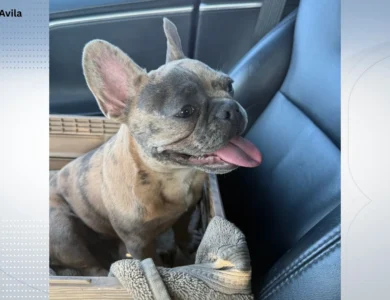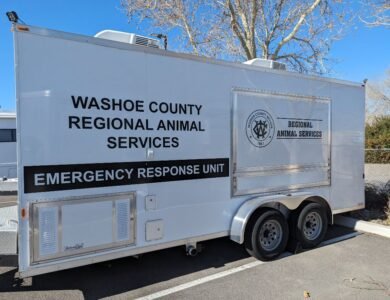We may earn a commission when you click on links across our website. This does not influence our opinions — learn more.
Henderson Dog Death Timeline Exposes 6-Hour Ordeal as Police Probe Home for Wider Neglect

Shocking new details have emerged in the death of Bailey, the small Maltese-Poodle mix at the center of one of Henderson’s most disturbing animal cruelty cases in recent memory.
A newly revealed police timeline shows Bailey was alive for more than six agonizing hours inside a sealed black trash bag before a neighbor heard faint breathing and rushed her to an animal hospital, where she later died.
The revelation has intensified scrutiny of the case against 60-year-old Randy Lee Katz and raised new questions about what was happening inside his Southern Highlands home, where two additional dogs were seized during a search warrant.
Investigators now believe Bailey was placed in the tied, airtight bag shortly after 11:57 a.m. on November 4, directly contradicting Katz’s claim that he discovered Bailey already dead in the street.
Police say his story is incompatible with the medical evidence, which documented bruising, dehydration, a puncture wound, and signs of blunt-force trauma — all injuries consistent with suffering, not immediate death.
The fact that Bailey was still breathing when the neighbor opened the bag at around 6:30 p.m. has become the defining detail in the case, effectively destroying Katz’s version of events.
The updated timeline, combined with the discovery of other dogs inside the home and physical evidence found during the search warrant, has shifted the investigation from a single act of alleged cruelty to a wider inquiry into whether multiple animals may have been living in dangerous or neglectful conditions.
With necropsy results pending and a December 2 court date approaching, the Bailey case is rapidly becoming one of the most closely watched animal welfare investigations in Clark County.
What Officers Found Inside The Home
When officers executed the search warrant on November 7 — three days after Bailey died — they removed at least two additional dogs from the residence, placing them into protective custody.
Henderson Police Chief Reggie Rader confirmed the seizure but declined to release specifics about their health or living conditions, citing the active investigation.
The lack of detail has only deepened public speculation about whether these dogs were also suffering or at risk inside the home.
Advocates have raised urgent questions about whether the animals were dehydrated, injured, fearful, or confined in unsafe spaces.
Officers would have had a clear view of their environment during the search, yet officials have not disclosed what they observed, what prompted the immediate removal, or whether similar signs of distress were present in the other animals.
The silence surrounding their condition has become a central tension point as the case widens beyond Bailey.
What is known is that authorities do not typically seize pets unless significant concerns about welfare or imminent harm are present.
The decision to remove multiple animals strongly suggests officers identified conditions that extended beyond Bailey’s suffering, and animal welfare groups are now calling for full transparency regarding what was found.
Physical Evidence Suggesting A Troubling Pattern
Inside Katz’s home, detectives documented a series of items raising fresh questions about what may have occurred before Bailey’s confinement.
Police found black plastic trash bags identical to the one Bailey had been tied inside — a chilling detail given the precise match.
Investigators also recovered blue disposable gloves, the same type discovered in the trash bag with Bailey.
Their presence has fueled concerns that handling, confinement, or concealment of animals may have been more deliberate than Katz admitted.
More troubling still, officers documented apparent blood on the floor near a dog kennel, collecting two swabs from the scene.
The location of the blood — adjacent to an animal confinement space — has raised serious questions about whether injuries occurred there and whether multiple animals may have experienced harm.
Investigators have not confirmed the source of the blood, but it has become a critical piece of evidence as they examine the broader environment Bailey and the other dogs lived in.
The physical findings, combined with the updated timeline showing Bailey was alive inside the sealed bag for more than six hours, create a portrait of an environment where animals may have been subjected to dangerous conditions long before Bailey’s final suffering.
The Updated Timeline
The most significant development in the case emerged with the detailed reconstruction of Bailey’s final hours.
According to investigators:
Shortly after 11:57 a.m., Bailey was placed inside a sealed black plastic trash bag.
This timestamp is based on Katz’s own admissions and forensic analysis of events inside the home.
At 5:15 p.m., Katz claimed he discovered Bailey dead in the street, placed her into the trash bag, and began walking around looking for a trash can.
Investigators now deem this account impossible in light of Bailey’s condition and survival.
Around 6:30 p.m., a neighbor discovered the tied bag and heard faint, labored breathing coming from inside.
When the neighbor opened it, Bailey was alive — barely — forcibly dehydrated, critically weak, and suffering from injuries inconsistent with a natural death.
At the animal hospital, veterinarians recorded severe dehydration, bruising to the armpit and abdomen consistent with kicking, a puncture or bite wound to the neck, and signs of blunt force trauma.
Despite emergency treatment, Bailey died later that evening.
The key fact — that Bailey lived inside the sealed bag for more than six and a half hours — has become the element that fundamentally undermines Katz’s entire defense.
This is not consistent with disposing of an already-dead dog.
It indicates prolonged suffering, conscious confinement, and a sustained failure to seek veterinary care.
Previous Police Visit Raises Serious Oversight Questions
The new timeline has also put renewed focus on a previous police visit to Katz’s home on October 27, just nine days before Bailey’s death.
Officers entered the residence during a medical emergency involving Katz’s elderly mother.
Body-worn camera footage confirmed that Bailey was alive and inside the home at that time.
Advocates now want to know what else officers may have observed during that welfare check.
If any signs of neglect, injury, or concerning environmental conditions were visible during the October 27 call, it is unclear whether they were documented or whether officers had reason to escalate the matter.
The proximity between the two events has raised difficult questions about whether early intervention could have prevented Bailey’s suffering or shed light on the condition of the other dogs.
For now, the October 27 response remains a haunting footnote: a moment where signs could have been noticed, but no follow-up occurred.
A Disturbing Account From Katz’s Girlfriend
Adding another layer of complexity, Katz’s girlfriend told investigators that one of his other dogs had recently been seriously injured in a coyote attack, and Katz said he disposed of Bailey because he “did not want to get caught” and did not want her upset.
This admission has been interpreted as evidence of consciousness of guilt — but it also opens doors to questions about the treatment and recovery of the other animal allegedly attacked.
Investigators are now looking into whether that injured dog was one of the animals seized during the search warrant and whether it received proper medical treatment at the time.
The compressed timeline of two dogs suffering serious injuries — one from wildlife, one from suspected abuse — has fueled concerns about whether multiple pets were living in dangerous circumstances inside the home.
The girlfriend’s account suggests emotional turmoil inside the household, but it also raises the question of whether other animals suffered unnoticed or untreated injuries before police intervention.
Echoes Of Other Neglect Cases In Nevada
Animal welfare professionals say the Katz case bears troubling similarities to other recent Nevada cruelty cases where investigations into one animal uncovered deeper, systemic neglect.
While the number of animals involved in Katz’s home is far smaller than some massive hoarding cases, experts warn that the warning signs — multiple pets, inconsistent accounts, injuries, and concerning home conditions — mirror patterns seen in broader neglect environments.
Advocates are now calling for statutory changes requiring follow-up visits anytime animals are seen during unrelated emergency responses.
They argue that Bailey’s case demonstrates how suffering can remain hidden behind closed doors unless proactive mechanisms are in place to check on animal welfare when warning signs first appear.
What Happens Next For The Seized Dogs
The two surviving dogs remain in protective custody, where they will stay until the criminal case concludes or a judge orders otherwise.
Their long-term fate — return to Katz, permanent rehoming, or continued shelter care — hinges on the outcome of the investigation and the results of Bailey’s necropsy, which is still pending.
Shelters across Southern Nevada are already strained from recent large-scale cruelty seizures, and taking in additional animals requiring potential medical or behavioral treatment has added to their resource burden.
Advocates are urging transparency from authorities regarding the dogs’ health and recovery, hoping to ensure that their welfare remains a priority as the case progresses.
Case Status And Upcoming Dates
Bailey’s body underwent necropsy on November 5, and results are expected to play a pivotal role in the prosecution’s case.
Katz was arrested on November 7 after Bailey’s microchip linked her to his residence.
He has since posted bail and is scheduled to appear in court on December 2.
The central fact driving the investigation — and destroying Katz’s defense — is now unmistakable: Bailey was alive inside that sealed trash bag, alive when the neighbor heard her faint breathing, alive upon arrival at the animal hospital, and only died later that night after hours of suffering.
For questions or to report suspected animal cruelty in Henderson, residents can contact the Henderson Police Department at 702-267-5000 or dial 911 in emergencies.



